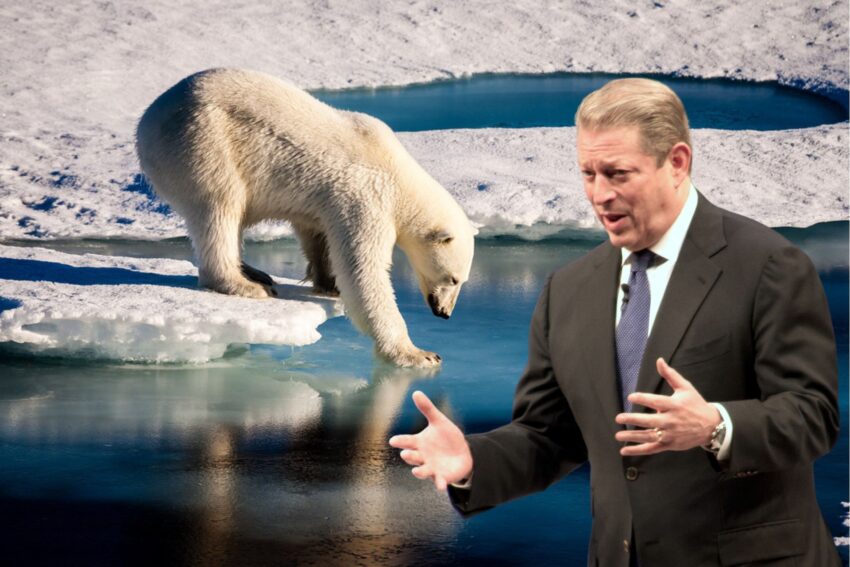In 2006, Al Gore’s documentary “An Inconvenient Truth” became a touchstone for climate activism, projecting alarming visions of the future if global temperatures continued to rise unchecked. However, as we stand in late 2024, it’s crucial to critically reassess these predictions, not just for historical accuracy but to understand the broader implications of climate alarmism.
1. The Myth of an Ice-Free Arctic Summer by 2013
Prediction: Gore forecasted that Arctic summers could be ice-free by 2013.
Reality: This dire prediction did not come to pass. While Arctic ice has diminished, the summer of 2024, like those before it, still sees significant ice coverage. This serves as a reminder that dramatic predictions can often be exaggerated for effect.
2. Exaggerated Sea Level Rise
Prediction: The film suggested sea levels could rise 20 feet, potentially submerging coastal cities.
Reality: By 2024, sea levels have risen, but not to the catastrophic levels suggested. Since the film came out, levels rose about 4.5 millimeters. The rhetoric around rising waters, while grounded in some truth, was seriously inflated, casting doubt on the urgency portrayed.
3. No More Snow on Kilimanjaro
Prediction: Africa’s tallest mountain would have no more snow cover on or before 2016.
Reality: Kilimanjaro is still getting covered by many, many feet of snow every year.
4. Polar Bear Extinction
Prediction: Arctic polar bears are dying and drowning due to a lack of sea ice.
Reality: Polar bear populations are actually increasing. There is no evidence that they have been drowning at an increasing rate.
5. Overblown Migration Projections
Prediction: Gore claimed climate change would displace 100 million people by 2020.
Reality: Mass migration is indeed a growing issue, but attributing exact numbers like 100 million by such a specific date oversimplifies the complex socio-economic factors at play. How many people have been flooding into the United States and Europe due to “climate change” vs people coming for economic opportunities and open border policies, as well as wars in the Middle East? This prediction reflects a tendency to use shock value over nuanced analysis.
6. The Collapse of the Gulf Stream
Prediction: The film suggested a potential collapse of the Gulf Stream with dire consequences for Europe.
Reality: While there are ongoing studies about the stability of ocean currents, no such collapse has occurred, highlighting the speculative nature of such forecasts.
7. Low-Lying Inhabited Pacific Atolls Indundated
Prediction: Low-lying inhabited Pacific atolls “are being inundated because of anthropogenic global warming.”
Reality: This has not happened. None have been evacuated. None have been overrun.
8. Katrina-like Catastrophes as the New Norm
Prediction: Gore implied that hurricanes of Katrina’s magnitude would become commonplace.
Reality: The science on hurricanes and climate change is complex. While there might be an increase in storm intensity, the direct link to a surge in frequency or severity of landfalling hurricanes hasn’t been conclusively demonstrated. In 2006 no hurricanes made landfall in the continental United States. Over the next decade, no major hurricanes hit the USA. In 2022, NOAA reported, “We conclude that the historical Atlantic hurricane data at this stage do not provide compelling evidence for a substantial greenhouse warming-induced century-scale increase in: frequency of tropical storms, hurricanes, or major hurricanes, or in the proportion of hurricanes that become major hurricanes.” This prediction plays into a narrative of fear rather than fact.
9. Overstated Species Extinction
Prediction: Up to a third of all species could disappear by the end of the century.
Reality: While biodiversity loss is a grave concern, the timeline and scale of extinction as portrayed were overly dramatic. This alarmism can detract from the ongoing, vital conservation work and the realistic pace at which these issues are being addressed.
Conclusion
Al Gore’s “An Inconvenient Truth” was the big catalyst for shifting the public’s focus on climate change, and it’s important to approach its legacy with a critical eye. The discrepancies between predictions and reality serve as a lesson in the pitfalls of climate alarmism. When engaging with contemporary climate change discourse, we must remember these instances where alarmist predictions did not materialize as promised. We must demand a more measured and evidence-based approach to public communication on environmental issues.



Les phénomènes type Katrina sont provoqués par haarp